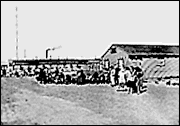Japanese Relocation Centers

During World War II, nearly 120,000 Japanese Americans were put in camps
 Japanese-American Internment Camp: Tule Lake, California Related Links
For More InformationThe San Francisco Museum: National Park Service: Historica Canada: "...I remember my mother wrapping "Two weeks after his twenty-fifth birthday, Ichiro got off a bus at Second and Main in Seattle. He had been gone four years, two in camp and two in prison. Walking down the street that autumn morning with a small, black suitcase, he felt like an intruder in a world to which he had no claim. It was just enough that he should feel this way, for, of his own free will, he had stood before the judge and said that he would not go in the army. At the time there was no other choice for him. That was when he was twenty-three, a man of twenty-three. Now, two years older, he was even more of a man." |
On February 19, 1942, soon after the beginning of World War II, Franklin D. Roosevelt signed Executive Order 9066. The evacuation order commenced the round-up of 120,000 Americans of Japanese heritage to one of 10 internment camps—officially called "relocation centers"—in California, Idaho, Utah, Arizona, Wyoming, Colorado, and Arkansas.
Why Were the Camps Established?
Roosevelt's executive order was fueled by anti-Japanese sentiment among farmers who competed against Japanese labor, politicians who sided with anti-Japanese constituencies, and the general public, whose frenzy was heightened by the Japanese attack of Pearl Harbor. More than two-thirds of the Japanese who were interned in the spring of 1942 were citizens of the United States.
Similar Orders in Canada
In Canada, similar evacuation orders were established. Nearly 23,000 Nikkei, or Canadians of Japanese descent, were sent to camps in British Columbia. It was the greatest mass movement in the history of Canada.
Though families were generally kept together in the United States, Canada sent male evacuees to work in road camps or on sugar beet projects. Women and children Nikkei were forced to move to six inner British Columbia towns.
Conditions in the U.S. Camps
The U.S. internment camps were overcrowded and provided poor living conditions. According to a 1943 report published by the War Relocation Authority (the administering agency), Japanese Americans were housed in "tarpaper-covered barracks of simple frame construction without plumbing or cooking facilities of any kind." Coal was hard to come by, and internees slept under as many blankets as they were alloted. Food was rationed out at an expense of 48 cents per internee, and served by fellow internees in a mess hall of 250-300 people.
Leadership positions within the camps were only offered to the Nisei, or American-born, Japanese. The older generation, or the Issei, were forced to watch as the government promoted their children and ignored them.
Eventually the government allowed internees to leave the concentration camps if they enlisted in the U.S. Army. This offer was not well received. Only 1,200 internees chose to do so.
Legal Challenges to Internment
Two important legal cases were brought against the United States concerning the internment. The landmark cases were Hirabayashi v. United States (1943), and Korematsu v. United States (1944). The defendants argued their fifth amendment rights were violated by the U.S. government because of their ancestry. In both cases, the Supreme Court ruled in favor of the U.S. government.
Closure of the Camps
In 1944, two and a half years after signing Executive Order 9066, fourth-term President Franklin D. Roosevelt rescinded the order. The last internment camp was closed by the end of 1945.
Government Apologies and Reparations
Forced into confinement by the United States, 5,766 Nisei ultimately renounced their American citizenship. In 1968, nearly two dozen years after the camps were closed, the government began reparations to Japanese Americans for property they had lost.
In 1988, the U.S. Congress passed legislation which awarded formal payments of $20,000 each to the surviving internees—60,000 in all. This same year, formal apologies were also issued by the government of Canada to Japanese Canadian survivors, who were each repaid the sum of $21,000 Canadian dollars.
Other Groups in the Camps
While Japanese-Americans comprised the overwhelming majority of those in the camps, thousands of Americans of German, Italian, and other European descent were also forced to relocate there. Many more were classified as "enemy aliens" and subject to increased restrictions.







